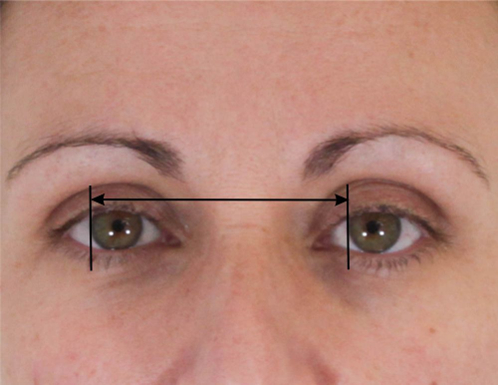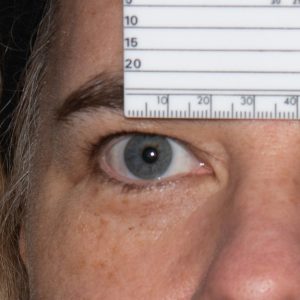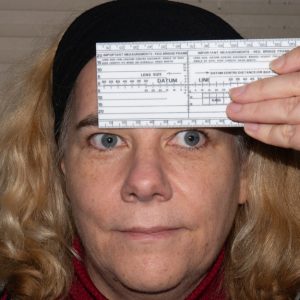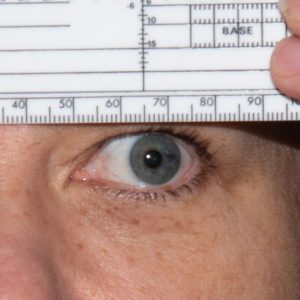Take Your Measurements
Taking your Measurements
It is crucial that when we make your spectacles, the optical centre of the lens sits in front of your pupils, giving you the best vision possible.
Pupillary Distance – PD
For every pair of spectacles, we need a measurement usually referred to as your PD, which stands for Pupillary Distance. This is the distance between your pupils measured in millimetres.
This will be in the range of 56-70mm for most people. It would be unusual (but not impossible) for an adult PD to lie outside this range.

Although we are measuring the distance between the centre of your pupils, this isn’t easy with a ruler. So instead, we measure the distance from the outside of the iris in one eye to the inside of the iris in the other. The contrast between the coloured part of your eye (iris) and the white part (sclera) makes it easier to measure, and the distance is the same. Once you are an adult and have stopped growing, this measurement will stay the same. We can get this information in several ways.
- Your optician may give it to you. It is not generally written on the prescription, and you may have to ask. In most cases, opticians are happy to supply this, although they may charge extra.
- We can measure it from a previous pair of spectacles. If we are reglazing your frame, simply send it to us as requested, and we will take the PD measurement from these. We can tell if they are distance, reading or otherwise.
- You can send us a photo of yourself wearing your current spectacles straight onto the camera and as big as possible. We have software that allows us to measure the PD from the picture. To do this, we need to know the size of your frame. You’ll find this on the inside, usually on one of the sides but occasionally inside the bridge. It will be in the format of 53/16 or 49/20, although it may be written as 50 □ 17 . Send it to sales@favershamoptical.com labelled with your name and the frame size, and we will email you your PD.
- It is possible to measure this yourself or with the help of a friend using nothing more than a ruler (and a flat mirror if doing it yourself) using the procedure below. Don’t worry, we have a good idea of what your PD should be, and we will query anything that doesn’t look correct.
- If you have a typical prescription, we can use an average value for a man or a woman based on thousands of previous measurements. It is always best to use methods 1,2 or 3, but unless you have a high prescription, an average PD will generally be ok.
Measure your PD


Most normal rulers will be upside down. If you are having trouble reading the ruler, you could try placing the ruler the right way up on your nose, but be careful to keep the ruler straight. In this instance, the PD is 63mm.


Make sure you look straight ahead directly in front of the mirror.
This takes a bit of practice, but this method is how I have taught probably hundreds of members of staff how to take a PD. We suggest taking three measurements and using an average value. Get a friend to check if you are unsure.
Your distance PD will be different to your near PD as when we read, our eyes rotate inwards slightly to allow us to focus on an object that is close to us. This means your near PD will be smaller than your distance PD. We will calculate your near PD from your distance PD precisely the same way as your local Optician would do.
Bifocals and Varifocals
If you’re ordering a Bifocal or Varifocal lens, we’ll need an extra measurement to determine where to set the segment for the bifocal or the centre of distance vision for the varifocal. This is customarily referred to as the Height.
If we are reglazing your old spectacles, we can take this directly from your old pair, and nothing more needs to be done.
However, if you are ordering a new pair, we need to see the new frame on you, as this measurement depends on where the frame sits. To do this, once we have received your order, we will send you the frame. We then need a photo like that requested above for the PD measurement (we can do both from the same image). Send it to sales@favershamoptical.com labelled with your name, and we will order the lenses.
We cannot order the lenses before we get this measurement as it helps determine which size of lens we need. Then return the frame to us in the pre-addressed bag so we can put the lenses in.
We do not need heights for distance, reading or intermediate lenses.
These two measurements are all we need to make any pair of spectacles and are exactly how your local Optician would do it. If you have any problems, please contact us at sales@favershamoptical.com